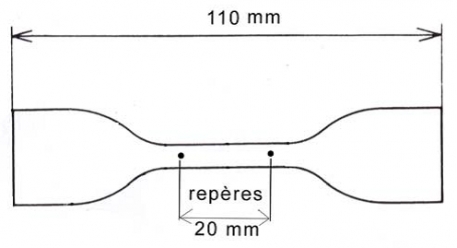RUBBER AND SILICONE TENSILE STRENGTH AND ELONGATION AT BREAK
On 29-01-2013
Pulling a rubber band will lead to rubber deformation, it will get longer while its section will get reduced, and it will endly break.
To qualify a rubber mechanically, it is necessary to measure the task needed to get its rupture.
Rubber test sample extension will be registered at the break out level.
It is necessary to use a traction device (dynometer) to measure this strength. Modern equipment are provided with an extensometer which, by following optically or mechanically 2 marks, can measure at any time the size of the rubber test sample during the extension pulling stage and when breaking point arrives.
Rubber test sample is defined by the NF T 46-006 norm. It has a bone shape or a ring with 4 sizes for the bone shaped sample (H1 to H4).
H2 size rubber sample

The most commonly used rubber test sample is a bone shaped rubber sample (H2 size) which is cut off in a 2 mm thickness rubber sheet. Its central part shows a rectangular section of 4 x 2 mm with a 25 mm length. It is the narrow part of the test sample, and rupture will occur in this area. The 2 marks (20 mm off) for the extension measure are also in this area.
Ring shaped test sample has a size of Ø 44,6 x Ø 52,6 mm with a 4 mm thickness. During its extension, it is rotating so that no particular zone will be affected.
Traction speed is 500 mm per minute. Traction resistance is measured in MPa, and extension in %. With an H2 rubber test sample, for 100 % extension, the distance between the 2 markings will have reached 40 mm.
We use in our laboratory bone shaped test samples on an electronic traction testing machine equipped with an optical extensometer. So, the traction resistance measure cannot be altered by clips following mechanically the 2 markings. All our rubber compounds are tested before being used for production.
Most performing rubbers can reach a 40 MPa traction resistance. Depending on mixtures and on hardness, rubbers are usually between 10 and 30 MPa, while silicons are between 4 and 10 MPa. This difference between rubber and silicon will be reduced while temperatures are increasing.
Hardness is related to extension rupture. However, mixture adaptations will have elongation influence on the results. Some values : a 95 Shore A rubber : 100 up to 150 %. a 60-70 Shore A : 300 up to 500 %. a 40 Shore A : 500 up to 700 %. Higher values (800 up to 1.000 %) can be obtained for special applications with specially developed compound mixtures.
- NEWS N°184, Production of bipolar plates for fuel cells using the LSR injection process, type 3025-40 or EPDM, FKM, ...
- NEWS N° 182 - The CHEVALIER - CLERET - ELTEC Group in summury
- CHEVALIER CLERET ELTEC SILICONES - CAOUTCHOUCS ECO RESPONSIBLE - French Business Climate Pledge 11/12/2017
- FLUORINATED ELASTOMER FKM FPM RUBBER FOR PHARMACEUTICAL USES & FOOD CONTACT APPLICATIONS ALSO STERILIZABLE
- ELASTOMERS COMPARATIVE – TPE TPV THERMOPLASTICS ELASTOMER - HCR HEAT CURING ELASTOMERS
- TRIPLE ANNIVERSARY FOR CHEVALIER CLERET ELTEC RUBBER AND SILICONE AND LSR
- SELF LUBRICATED NITRILE NBR COMPOUND
- NITRILE NBR FOR GAZ APPLICATIONS NF EN 549
- RUBBER PARTS INSPECTION & "IN PRODUCTION" FUNCTIONNEL TESTS
- HOW TO GET MOULDED RUBBER PARTS & THERMOPLASTIC TP + SELF BONDING LSR CO INJECTION
- EXTREME PERFORMANCES FOR RUBBERS AND NEW OPPORTUNITIES THROUGH FLS FFLS FLUORO LIQUID SILICONE NEW GRADES AVAILIBITY
- RUBBER AND SILICONE LSR THERMAL EXPANSION
- RUBBER REUSE ( HIGH TEMPERATURE VULCANIZATION / CURE ELASTOMERS; SILICONES & LIQUID SILICONE RUBBERS / LSR)
- http://en.wikipedia.org/wiki/Synthetic_rubber
- http://en.wikipedia.org/wiki/Silicone
- HYBRIDS : LIQUID SILICONE RUBBER LSR SELF BONDING ON TP - THERMOPLASTIC (2on2) also named "self bonding lsr silicone"
- HYBRIDS : RUBBER BONDING ON METAL (1on2) also named "rubber metal"
- RUBBER FRICTION
- SILICONE AND RUBBER TEARING
- SILICONE AND RUBBER PARTS STORAGE
- RUBBER AND SILICONE TENSILE STRENGTH AND ELONGATION AT BREAK
- RUBBER TANGENT DELTA (TAN DELTA)
- RUBBER'S RESILIENCE
- YOUNG MODULUS FOR RUBBER
- RUBBER PARTS ASSEMBLING & MOUNTING
- RUBBER HARDNESS MEASUREMENT
- RUBBER COMPRESSION SET
- TO BE SEEN IN PHARMAPACK 2012 - Paris
- SILICONE AND ELASTOMERS SELF LUBRICATION
- ELASTOMERS POST CURING
- CUSTOM LSR COLORS
- 7 th TECH DAYS
- 6èmes journées techniques





